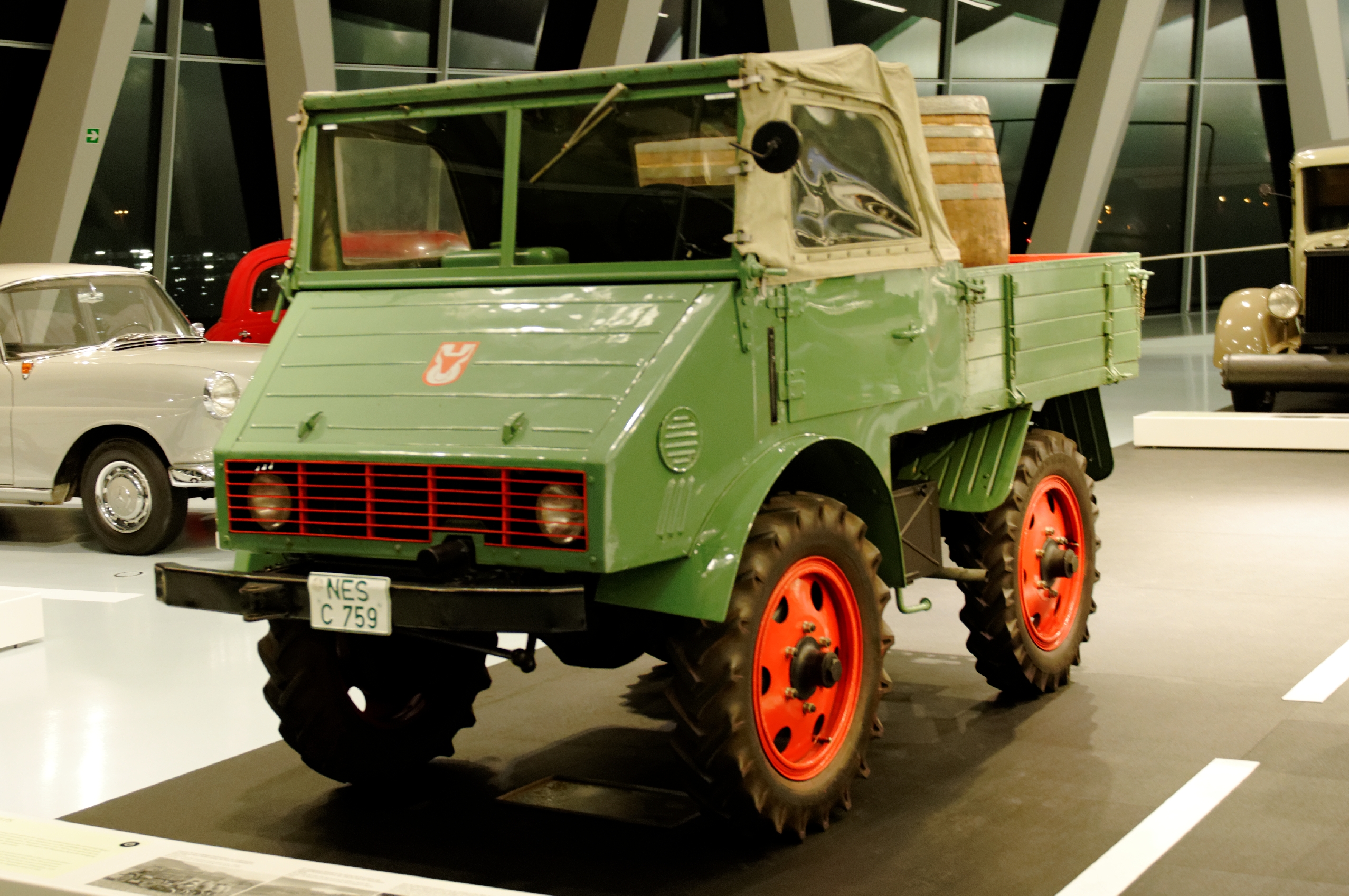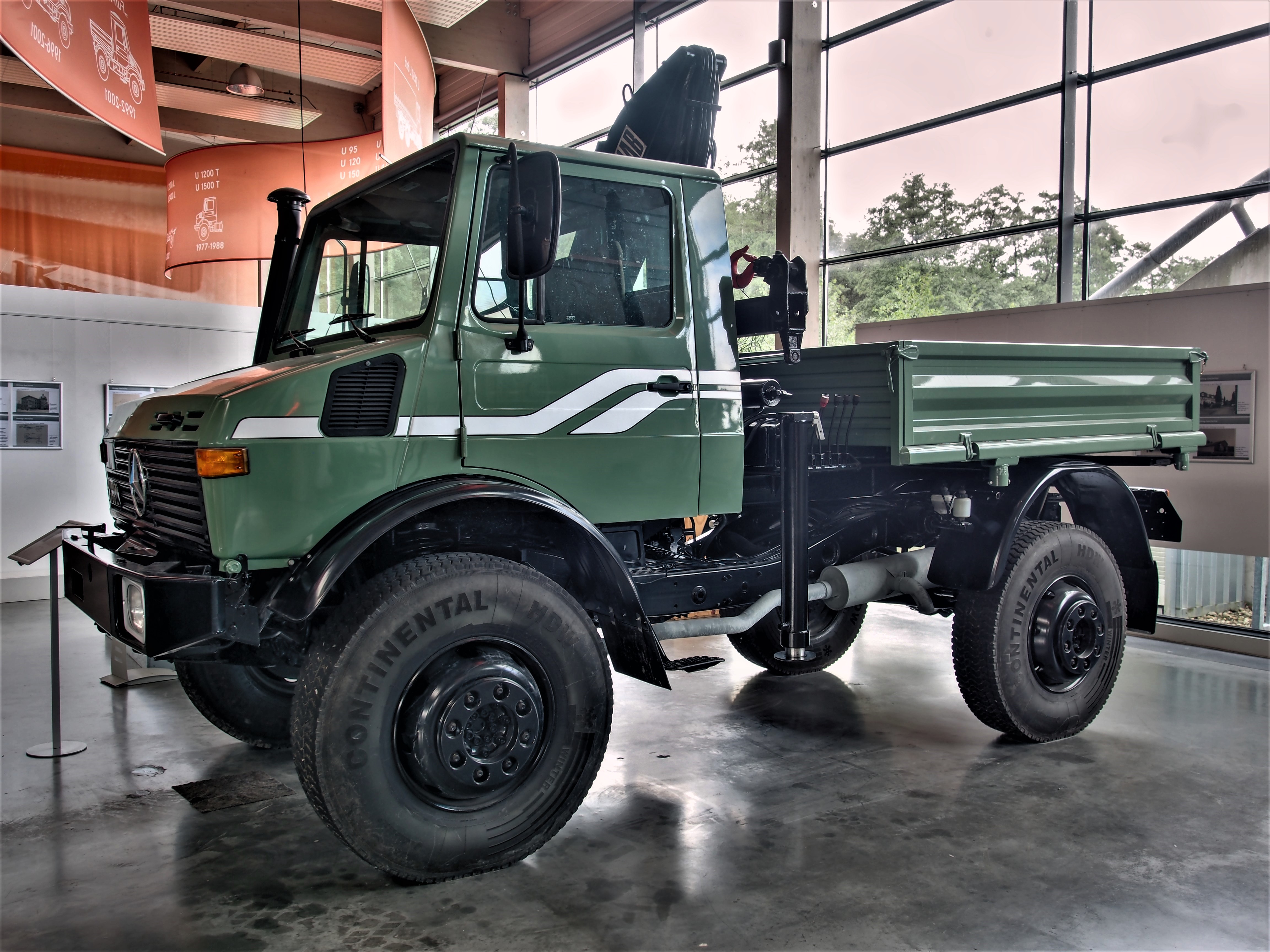|
Unimog 406
The Unimog 406 is a vehicle of the Unimog-series by Mercedes-Benz. A total of 37,069 units were manufactured by the Daimler-Benz AG in the Unimog plant in Gaggenau from 1963 to 1989. The 406 was the first medium duty Unimog, having a larger wheelbase of 2380 mm and more than twice the engine power of the Unimog 401. Unlike the initial Unimog, the 406 does not have a car engine but a heavy duty truck engine instead. Several following Unimog versions were based on the 406. There were elevenVogler, p. 57 different ''types'' made of the Unimog 406, which were available in four ''models'' (U 65 – U 84) with a closed two-door or four-door cab, as ''Cabrio'' and as an OEM part (a "half" Unimog lacking the rear part, as a basis for third party vehicle manufacturers). During its long production period, the 406 received several technical refinements. In 1964, the precombustion chamber diesel engine OM 312 was replaced with the direct injected OM 352. Disc brakes followed in 1973. ... [...More Info...] [...Related Items...] OR: [Wikipedia] [Google] [Baidu] |
Daimler-Benz AG
The Mercedes-Benz Group AG (previously named Daimler-Benz, DaimlerChrysler and Daimler) is a German multinational automotive corporation headquartered in Stuttgart, Baden-Württemberg, Germany. It is one of the world's leading car manufacturers. Daimler-Benz was formed with the merger of Benz & Cie. and Daimler Motoren Gesellschaft in 1926. The company was renamed DaimlerChrysler upon acquiring the American automobile manufacturer Chrysler Corporation in 1998, and was again renamed Daimler AG upon divestment of Chrysler in 2007. In 2021, Daimler AG was the second-largest German automaker and the sixth-largest worldwide by production. In February 2022, Daimler was renamed Mercedes-Benz Group. The Mercedes-Benz Group's marques are Mercedes-Benz for cars and vans (including Mercedes-AMG and Mercedes-Maybach) and Smart. It has shares in other vehicle manufactures such as Daimler Truck, Denza, BAIC Motor and Aston Martin. By unit sales, the Mercedes-Benz Group is the thirte ... [...More Info...] [...Related Items...] OR: [Wikipedia] [Google] [Baidu] |
German Agricultural Society
The German Agricultural Society (''Deutsche Landwirtschafts-Gesellschaft''), commonly known as DLG, is an international non-profit organisation for agricultural industry in Germany. DLG was founded in 1885 by Max Eyth, has over 23,000 members as of 2011 and is headquartered in Frankfurt am Main. Its main purpose is to promote technical progress and scientific advances in the food and agricultural industry, including setting standards.German Agricultural Society: About the German Agricultural Society read on January 1, 2008 Activities The main activities of DLG are: * Arrangement of seminars and other educational activities for its members * Advise to members * Publication of books and magazines related to the food and agriculture industry * Testing of food and ...[...More Info...] [...Related Items...] OR: [Wikipedia] [Google] [Baidu] |
Knock-down Kit
A knock-down kit (also knockdown kit, knocked-down kit, or simply knockdown or KD) is a collection of parts required to assemble a product. The parts are typically manufactured in one country or region, then exported to another country or region for final assembly. A common form of knock-down is a complete knock-down (CKD), which is a kit of entirely unassembled parts of a product. It is also a method of supplying parts to a market, particularly in shipping to foreign nations, and serves as a way of counting or pricing. CKD is a common practice in the automotive, bus, heavy truck, and rail vehicle industries, as well as electronics, furniture and other products. Businesses sell knocked-down kits to their foreign affiliates or licensees for various reasons, including the avoidance of import taxes, to receive tax preferences for providing local manufacturing jobs, or even to be considered as a bidder at all (for example, in public transport projects with "buy national" rules). A ... [...More Info...] [...Related Items...] OR: [Wikipedia] [Google] [Baidu] |
Unimog 302 (7414531174)
The Unimog (, ) is a range of multi-purpose tractors, trucks and lorries that has been produced by Boehringer from 1948 until 1951, and by Daimler Truck (formerly Daimler-Benz, DaimlerChrysler and Daimler AG) since 1951. In the United States and Canada, the Unimog was sold as the Freightliner Unimog. Unimog production started in 1948 at in Göppingen. Daimler-Benz took over manufacture of the Unimog in 1951, and first produced it in their Gaggenau#Local Industry, Gaggenau plant. From 1951, the Unimog was sold under the Mercedes-Benz brand. However, the first Unimog to feature the three-pointed Mercedes-Benz star was only introduced in 1953. Since 2002, the Unimog has been built in the Mercedes-Benz truck plant in Wörth am Rhein in Germany. The Mercedes-Benz buses#Mercedes-Benz Türk, Mercedes-Benz Türk A.Ş. plant assembles Unimogs in Aksaray, Turkey. Unimogs were also built in Argentina (first ever country to do so outside Germany) by Mercedes-Benz Argentina S.A. under licence ... [...More Info...] [...Related Items...] OR: [Wikipedia] [Google] [Baidu] |
Unimog At Münster Nienberge
The Unimog (, ) is a range of multi-purpose tractors, trucks and lorries that has been produced by Boehringer from 1948 until 1951, and by Daimler Truck (formerly Daimler-Benz, DaimlerChrysler and Daimler AG) since 1951. In the United States and Canada, the Unimog was sold as the Freightliner Unimog. Unimog production started in 1948 at in Göppingen. Daimler-Benz took over manufacture of the Unimog in 1951, and first produced it in their Gaggenau plant. From 1951, the Unimog was sold under the Mercedes-Benz brand. However, the first Unimog to feature the three-pointed Mercedes-Benz star was only introduced in 1953. Since 2002, the Unimog has been built in the Mercedes-Benz truck plant in Wörth am Rhein in Germany. The Mercedes-Benz Türk A.Ş. plant assembles Unimogs in Aksaray, Turkey. Unimogs were also built in Argentina (first ever country to do so outside Germany) by Mercedes-Benz Argentina S.A. under licence from 1968 until 1983 (with some extra units built until 199 ... [...More Info...] [...Related Items...] OR: [Wikipedia] [Google] [Baidu] |
Unimog Ausbuchtung Frontzapfelle
The Unimog (, ) is a range of multi-purpose tractors, trucks and lorries that has been produced by Boehringer from 1948 until 1951, and by Daimler Truck (formerly Daimler-Benz, DaimlerChrysler and Daimler AG) since 1951. In the United States and Canada, the Unimog was sold as the Freightliner Unimog. Unimog production started in 1948 at in Göppingen. Daimler-Benz took over manufacture of the Unimog in 1951, and first produced it in their Gaggenau#Local Industry, Gaggenau plant. From 1951, the Unimog was sold under the Mercedes-Benz brand. However, the first Unimog to feature the three-pointed Mercedes-Benz star was only introduced in 1953. Since 2002, the Unimog has been built in the Mercedes-Benz truck plant in Wörth am Rhein in Germany. The Mercedes-Benz buses#Mercedes-Benz Türk, Mercedes-Benz Türk A.Ş. plant assembles Unimogs in Aksaray, Turkey. Unimogs were also built in Argentina (first ever country to do so outside Germany) by Mercedes-Benz Argentina S.A. under licence ... [...More Info...] [...Related Items...] OR: [Wikipedia] [Google] [Baidu] |
Unimog 406
The Unimog 406 is a vehicle of the Unimog-series by Mercedes-Benz. A total of 37,069 units were manufactured by the Daimler-Benz AG in the Unimog plant in Gaggenau from 1963 to 1989. The 406 was the first medium duty Unimog, having a larger wheelbase of 2380 mm and more than twice the engine power of the Unimog 401. Unlike the initial Unimog, the 406 does not have a car engine but a heavy duty truck engine instead. Several following Unimog versions were based on the 406. There were elevenVogler, p. 57 different ''types'' made of the Unimog 406, which were available in four ''models'' (U 65 – U 84) with a closed two-door or four-door cab, as ''Cabrio'' and as an OEM part (a "half" Unimog lacking the rear part, as a basis for third party vehicle manufacturers). During its long production period, the 406 received several technical refinements. In 1964, the precombustion chamber diesel engine OM 312 was replaced with the direct injected OM 352. Disc brakes followed in 1973. ... [...More Info...] [...Related Items...] OR: [Wikipedia] [Google] [Baidu] |
Unimog 435
The Unimog 435 is a vehicle of the Unimog-series by Mercedes-Benz. 30,726 vehicles were produced from 1975 to 1993 in eight different variants in the Mercedes-Benz Unimog-plant in Gaggenau. The vehicles were sold as ''Unimog U 1300 L'' and ''Unimog U 1700 L''. Best selling vehicle was the ''U 1300 L'', which was built as a special vehicle for the Bundeswehr and the German fire department often. The successor Unimog 437 with a similar appearance is still in production. The Unimog 436 is based on the Unimog 435. It is made for export and has a different cab. The names of Unimog-vehicles may create confusion, the ''U 1300'' belongs to the Unimog 425-series, while the ''U 1300 L'' belongs to the Unimog 435-series. Description The Unimog 435 belongs to the heavy duty Unimog series which started with the Unimog 425. Compared with the Unimog 425, the 435 has a longer wheelbase and more powerful engines. Just as the 425, it has t ... [...More Info...] [...Related Items...] OR: [Wikipedia] [Google] [Baidu] |
Unimog 425
The Unimog 425 is the first series production heavy duty Unimog series, made by Daimler-Benz from 1975 to 1988 in the Mercedes-Benz Gaggenau plant, alongside the long-wheelbase model Unimog 435. It was first presented to the public on the 1974 DLG show in Frankfurt, then named ''Unimog U 120'', indicating a power output of . However, series production models were equipped with or engines, and therefore called U 1300 and U 1500. Daimler-Benz made three types of the Unimog 425, and a total number of 3135 were built, making the 425 much rarer compared to the longer wheelbase, but otherwise similar Unimog 435, of which more than 30,000 were built. The 425 was the first Unimog to feature the "edgy cab", which is still used in the Unimog today. Technical description The Unimog 425 is a two-axle lorry with a downswept ladder frame and rear-wheel drive. Front-wheel drive can be manually enabled. Both axles are coil-sprung, live, portal axles, with panhard rods, torque tubes ... [...More Info...] [...Related Items...] OR: [Wikipedia] [Google] [Baidu] |
Unimog 421
The Unimog 421 is a vehicle of the Mercedes-Benz Unimog series, made by Daimler-Benz. In total, 18,995 units of the Unimog 421 were built from 1966 to 1989 in the Mercedes-Benz Gaggenau plant. It is a medium-sized vehicle bigger than the traditional Unimog 411, but smaller than the Unimog 406 The Unimog 406 is a vehicle of the Unimog-series by Mercedes-Benz. A total of 37,069 units were manufactured by the Daimler-Benz AG in the Unimog plant in Gaggenau from 1963 to 1989. The 406 was the first medium duty Unimog, having a larger whe .... Introduction of new heavy models and Unimog 411 production ceasing in the mid-1970s changed the Unimog 421's role in the Unimog lineup; it became the predecessor of the light Unimog series and thus succeeded the Unimog 411. Both short and long wheelbase versions, as well as "front half only" OEM part versions, were made. Technically, the Unimog 421 is based on the Unimog 406 and Unimog 411. The plane ladder frame and axles are Unimog 411 pa ... [...More Info...] [...Related Items...] OR: [Wikipedia] [Google] [Baidu] |
.jpg)




